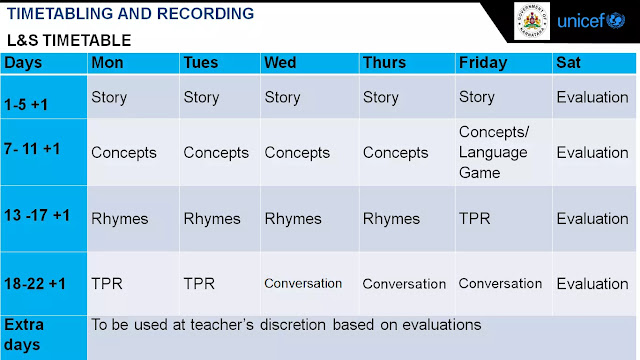Introduction
As English Nali-Kali Level-2 will be practically implemented in all the government schools across Karnataka, the teachers who will be handling ENK classes must be aware of the basics of the program. Thus in this post, we will take you through the ENK Level-2 L&S Learning Ladder, how to evaluate the students, and maintaining the Timetable and Recording the performance of the students.
You may also like:
{tocify} $title={Table of Contents}
L&S Learning Ladder
Nali Kali English follows 2 Learning Ladders, one for the Oral Curriculum (L&S) and the other for Reading and Writing (R&W). Each ladder has different sets of milestones.
 |
| L&S Learning Ladder |
In level 2, the L&S Ladder has 7 milestones of 50 steps.
Evaluation
Evaluation or Review is done at the end of each milestone and total evaluation is done at the end of L&S Ladder which is considered as Summative Assessment 2 (SA 2).
How is Total Evaluation Done?
The Total Evaluation is done by asking 2 questions from each segment. Questions are picked randomly from the Total Evaluation cards.
 |
| A Total Evaluation Card |
Completion of Total Evaluation indicates that the student has climbed up to the end of the L&S Ladder. He/she then marks the Pragati Nota. Remedial interventions will be taken up by the teacher for children who have not done well in the review.
Time-table and Recording
A Day's Time-table With Students at 2 Levels
A typical Nali Kali classroom in the second year has students at 2 different levels at multiple learning levels.
In such a scenario the teacher is expected to be aware of the amount of time to be spent on each level.
- Timetable be divided into units of 45 minutes of Oral English (L&S) and 35 minutes of R&W.
- The first 30 minutes of the Oral English class that deals with stories and concept presentations (that are passive activities where students sit and listen to the teacher) can be followed by 10 minutes of an active activity such as TPR or rhyme or language game with the whole class.
- The purpose of this is to give young students some time to stand up and move around before they settle into another 35 minutes of quiet activity in R&W. The 10 minutes can be used to revise TPR exercises, rhymes, and conversations of earlier months.
- In the last 2 weeks where students spend their time in active exercises, the last 10 minutes can be used for revising concepts/ story reading – quieting students down for the R&W class.
- The next 35 minutes are utilized in reading and writing activities.
Listening and Speaking Sessions
Oral activities are conducted using the whole class approach. As all these activities in a milestone are theme-based, the teacher does not lose time. She/he just follows the tempo and moves seamlessly from one activity to the other.
- The teacher has to bear in mind that Level 2 students have done the activities the year before so, her focus should be on level 1 students.
- After 15 minutes, the teacher shifts her focus to level 2 students and asks them to step forward and gives them conducts the activity.
- The same steps are followed as was done for level 1. If students of level 1 want to take part in the activity, she does not stop them. She Lets them take part in the activity but focuses her attention on level 2.
- The last 10 minutes are reserved for revising activities /concepts/ reading stories from the earlier months.
Time-table Management in English Nali-Kali
An important principle of teaching early learners is the need to alternate between active and passive work. Students from 3-8 years have shorter attention spans and can sit quietly and focus on an activity for about 20 minutes. In year 1 a number of activities are present in each oral class and this requirement is fulfilled. In year 2 given that 2 levels are present only one activity is taught in a single class. During sit down activities like concept presentation students sit for 40+40 minutes at a time causing restlessness and wandering attention. After spending 15 minutes a breakout session is introduced with an active activity such as TPR /rhymes /conversation. This session can be used to revise earlier themes.
The approximate 170 days of active teaching (when class is held) can be distributed into approximately 24 days for each theme. A rough timetable is given for the distribution of the theme and segments.
$ads={2}
One segment can be completed at a time. The 25 days be divided into units beginning with 5 days of story-telling & 1 day of evaluation, followed by 5-6 days of concept presentation (of which the last day or 2 are used for language games to reinforce vocabulary and grammar. The eval can be changed into a game).
The remaining 12 days can be spent on TPR, Rhyme and conversation.
Year Plan of L&S and R&W
The Year Plan below gives you an overview of how the different themes of L&S and milestones of R&W are covered.
 |
| Year Plan of L&S and R&W |
-----
Download the module: Learning Ladder, Evaluation, Time-table & Recording
Credits: Samagra Shikshana Karnataka and UNICEF {alertInfo}


